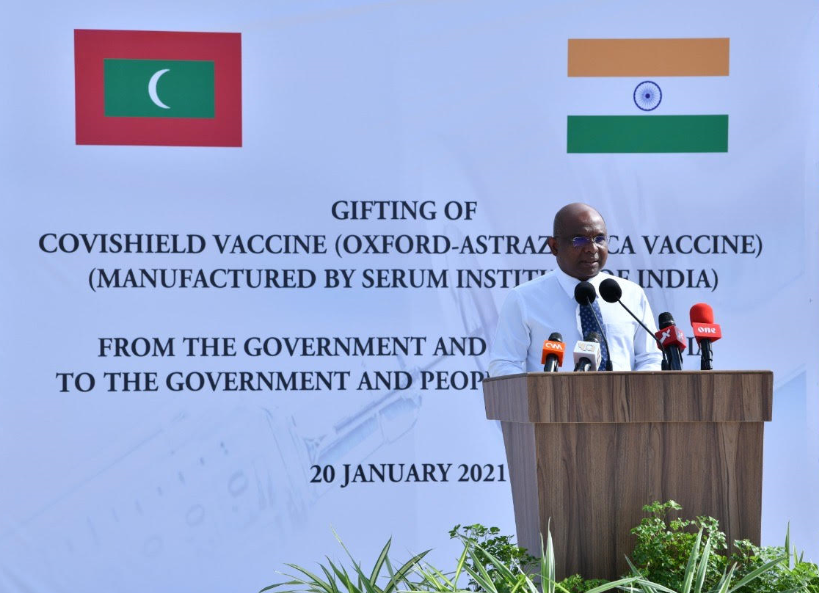Summary
Amid domestic criticism, the Indian government rolled out its COVID-19 vaccination programme in January 2021 with two locally-produced vaccines. To improve its regional standing, New Delhi has also begun exporting these vaccines to other countries. However, only time will tell if India’s vaccine diplomacy will redound to its benefit.
As India began vaccinating its citizens a few days ago, the government has also kicked off an ambitious exercise to export vaccines to its South Asian neighbours and some countries outside the region. India’s unprecedented vaccine diplomacy derives from its strength in producing vaccines and generic medicines that other countries rely on. Though early, the exercise comes out of a calculus – the pandemic is ebbing in India and that there is enough supply of vaccine doses to share, and that sharing will boost India’s standing after recent diplomatic missteps in South Asia. Vaccine diplomacy appears to be driven not only by an opportunity to amass goodwill amongst neighbours who have their recent qualms with New Delhi, but also as an opportunity to eclipse China, whose Sinovac vaccine has proven to be largely ineffective, if not risky to import and administer.
On 16 January 2021, India officially launched its COVID-19 vaccination programme, the world’s largest immunisation drive to mitigate the Coronavirus. Two locally-produced vaccines have been approved for restricted emergency use – Covishield, the licensed Oxford and AstraZeneca vaccine manufactured locally by Serum Institute of India; and Covaxin, developed by Bharat Biotech. The Indian government hopes both vaccines will complement existing interventions like masks and social distancing measures to curb COVID-19 infections and revive the flagging economy. Administering vaccine involves detailed logistical arrangements, including cold chain transport systems and personnel training, to ensure safe delivery across the country. New Delhi has also organised 29,000 cold storage units and trained 200,000 vaccinators and 370,000 team members for this purpose. The enormity of the task, however, comes with challenges.
Scientists and health experts lament that Covaxin, locally developed, has been approved in haste before completing Phase 3 trials and without concrete public data. Clinical trials help determine whether these vaccines produce the required immune response or have unacceptable or alarming side effects. Administering vaccines to the general population without completing trials, as a result, can be dangerous, denting the credibility of Indian vaccines and their development. Concerns also exist over the quality of cold chain management or storage, given inadequate public transport and congested roads. However, the government has assured citizens that Covaxin is safe and can be administered through the existing cold chain infrastructure.
India aims to fulfil domestic market requirements and use COVID-19 vaccines to forge new ties and strengthen old ones with regional and extra-regional partners. Using a vaccination grant assistance scheme, India has begun exporting vaccines. Bhutan was the first country to receive a shipment of COVID-19 vaccines on 20 January 2021. New Delhi has committed to despatch 20 million vaccine doses to its neighbouring countries in South Asia and key partners elsewhere. Talks regarding vaccine exports have occurred with Nepal, Bangladesh, Sri Lanka, Afghanistan, Seychelles and Mauritius. Brazil also secured two million doses of Covishield from India, allowing it to not rely solely on China’s Sinovac.
Clinching vaccine deals in South Asia could boost India’s regional standing, particularly with countries like Nepal, Sri Lanka and Bangladesh, with whom ties have soured for various reasons. Tensions between Nepal and India escalated over territorial claims in the disputed Kalapani region and relations with Bangladesh soured after the passing of the Citizenship (Amendment) Act 2019 and the National Register of Citizenship Bill. In December 2020, however, India’s Prime Minister Narendra Modi and his counterpart in Bangladesh, Sheikh Hasina, discussed the vaccine deal virtually, marking their first talks since last year’s drift. Of late, India-Sri Lanka ties have also been marred by burgeoning links between Sri Lanka and China over infrastructure and connectivity projects, especially relating to the Belt and Road Initiative. That said, Sri Lanka has also expressed a clear interest in India’s COVID-19 vaccines. While the vaccine grant assistance initiative cannot solve India’s squabbles with its neighbours, it can soothe recent tensions.
Though unclear whether India’s vaccine diplomacy will blunt China’s inroads into South Asia, India’s efforts could benefit from prevailing doubts around the efficacy of China’s Sinovac vaccine. Continued delays, inconsistent data, shoddy disclosures and misinformation campaigns against American vaccines have placed Beijing on the defensive, allowing competing vaccines, including those produced in India, to gain ground. China had hoped its vaccines would trumpet its scientific and diplomatic credentials, but delays in delivery to key partners like Brazil and Turkey have quashed this objective. Instead, Brazil turned to India to fill the gap.
As the world’s largest vaccine supplier responsible for 60 per cent of the global supply, India can earn goodwill from exporting the British-developed, locally-produced AstraZeneca vaccine. However, it remains to be seen if India can capitalise on the pandemic-induced geopolitical opportunity by backing vaccines with other levers like loans, grants and defence equipment. The jury is out on that count.
. . . . .
Ms Ramita Iyer is a Research Analyst at the Institute of South Asian Studies (ISAS), an autonomous research institute at the National University of Singapore (NUS). She can be contacted at isasrri@nus.edu.sg. Dr Karthik Nachiappan is Research Fellow at the same institute. He can be contacted at isaskn@nus.edu.sg. The authors bear full responsibility for the facts cited and opinions expressed in this paper.
Photo credit: MEA/Flickr
-
 More From :
More From :
-
 Tags :
Tags :
-
 Download PDF
Download PDF



